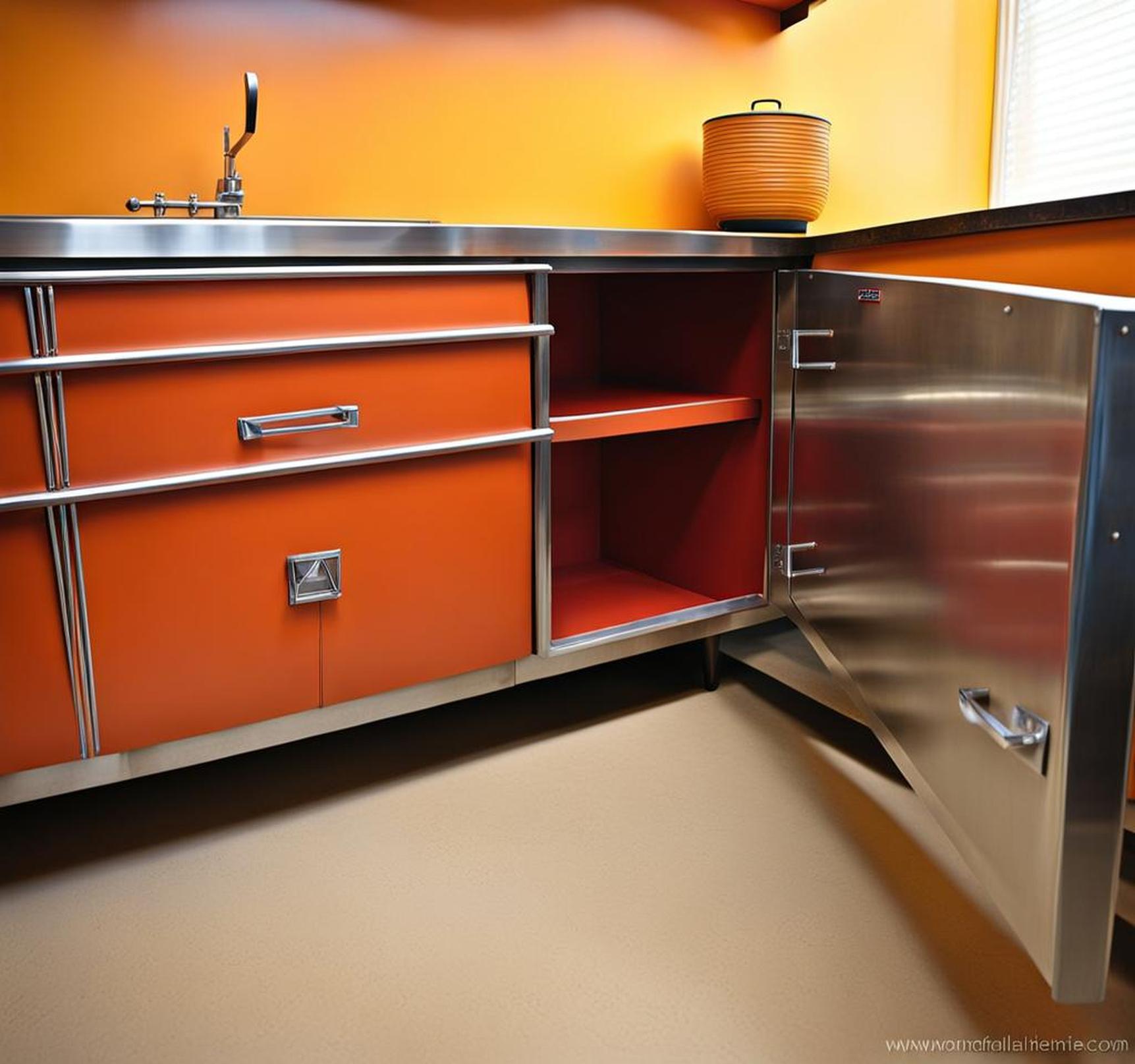1950s metal kitchen cabinets offer a great look for today’s vintage design enthusiasts. These midcentury relics conjure up images of postwar optimism and atomic-age style. Beyond just decorative appeal, the renewed popularity of 1950s metal cabinets provides a unique way to add historic charm to a contemporary kitchen.
So for designers, collectors, and homeowners looking to infuse their spaces with some Fabulous Fifties flavor, let’s delve into the world of vintage metal cabinets. We’ll explore the history behind these atomic-era antiques, where to find them, and how to restore 1950s metal cabinets to their former retro glory.
The Historical Origins of 1950s Metal Kitchen Cabinets
Metal kitchen cabinets first rose to prominence in the years following World War II. With the war over and the economy booming, many American families moved to the suburbs and outfitted their homes with modern conveniences. Sleek and durable metal cabinets aligned perfectly with the atomic era aesthetic of streamlined designs.
Companies like Youngstown, Geneva, and St. Charles led the way in metal cabinet manufacturing. With bold colors and space-age styling, their steel and aluminum cabinets soon found their way into millions of American kitchens. Tabletop sales demonstrations using miniature cabinet models became a popular merchandising tactic.
The Big Three: Youngstown, Geneva, and St. Charles
In the metal cabinet business, Youngstown, Geneva, and St. Charles ruled the roost. Collectively known as “The Big Three,” these major manufacturers churned out metal cabinets that suburban homeowners eagerly installed in their partitioned kitchens.

Of the Big Three, Youngstown stood at the head of the class. At its peak, the company produced around 300,000 steel cabinets annually at its Ohio plant. Youngstown’s popular freestanding cabinets came in a rainbow of 1950s color schemes.
The Rise of the Populuxe Era
With their promises of convenience and style for all, metal kitchen cabinets exemplified the consumer-driven Populuxe movement of the 1950s. Populuxe, a blend of Popular and Luxury, described the era’s tastes for inexpensively-produced goods dressed up in space-age flair.
While postwar patriotism fueled their initial popularity, by mid-decade metal cabinets evolved from staid white to a kaleidoscope of trendy pastel hues. This explosion of color aligned with the flashy, status-conscious Populuxe aesthetic.
Collecting Vintage 1950s Metal Cabinets Today
For today’s collectors, tracking down vintage 1950s metal cabinets offers an exciting treasure hunt through architectural salvage yards, flea markets, and online auctions. Avid seekers can still uncover museum-worthy pieces, but competition is stiff. Let’s explore some insider tips for locating these retro finds.
Where to Find 1950s Metal Cabinets
eBay and Etsy offer collectors a worldwide buffet of vintage cabinets. Locally, scouting antique shops and vintage home stores may yield rare treasures. Check classified ads, as collectors sometimes part with portions of their stash. Flea markets remain fertile hunting grounds, but prepare to compete with other mid-century aficionados.
Auctions through specialty sites like 1stDibs are ideal but expensive. Lesser-known local auctions sometimes slip under the radar. Estate sales in older neighborhoods also promise 1950s cabinet sightings.
Factors Impacting Cost
A pristine mint-condition 1950s Youngstown set could set you back five figures. More commonly, prices range from a few hundred dollars for cabinets needing restoration to several thousand for professionally refurbished pieces in vibrant retro colors.
Variables impacting value include:
- Brand names like Youngstown and Geneva
- Rare colors like turquoise or pink
- All original parts
- No rust or damage
One-of-a-kind customized pieces also command higher prices from serious collectors.
Restoring Retro Beauty
For design-lovers less concerned with perfection, restoring a set of vintage 1950s metal cabinets can be a fulfilling DIY adventure. Let’s explore some tips for revitalizing these atomic-era antiques.
Repairing Dents and Rust
Light dents can sometimes be carefully popped out, but deep dings may remain. Removing rust requires sanding, priming, and painting damaged areas. Replacing rust-damaged sections may be necessary.
Stripping and Repainting
1950s cabinets came in baked-on enamel finishes that hold up remarkably well. Stripping old paint requires potent chemical strippers. For repainting, durable enamels or powders coatings are recommended to emulate the original look.
Hardware Replacement
Missing or rusted hardware like hinges, handles, and latches can be replaced with period-appropriate parts available from specialty suppliers.
With some perseverance and elbow grease, salvaged steel cabinets can be returned to their former retro glory. For extensive restorations, hiring a professional may be worth the investment.
Beyond just decor, vintage 1950s metal cabinets serve as a tangible link to the optimism and futurism of the postwar era. Each restored set preserves a slice of midcentury design history to enjoy for years to come.
So for adventurous designers, these atomic antiques offer the chance to add a dash of retro nostalgia to modern kitchen spaces. With their sputnik chic and bold pops of color, few pieces capture the essence of the 1950s like these vintage steel cabinets.
